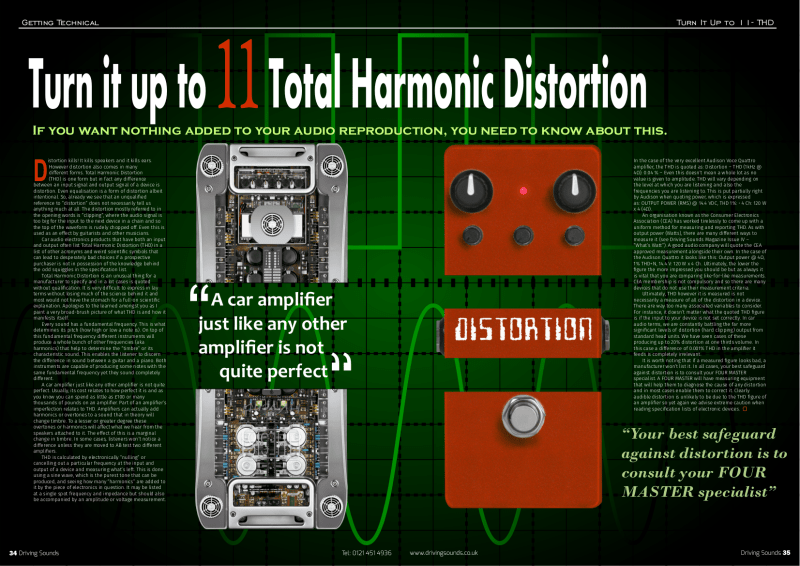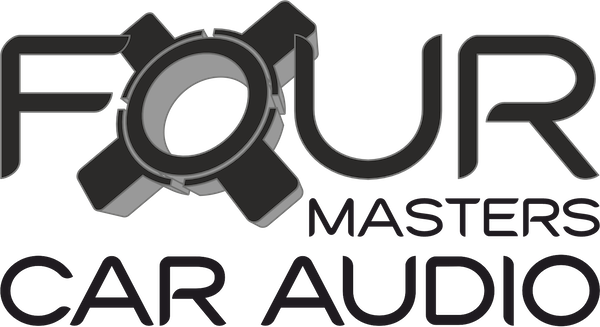
Turn it up to 11
Total Harmonic Distortion
Distortion kills! It kills speakers and it kills ears. However distortion also comes in many different forms. Total Harmonic Distortion (THD) is one form but in fact any difference between an input signal and output signal of a device is distortion. Even equalisation is a form of distortion albeit intentional. So, already we see that an unqualified reference to “distortion” does not necessarily tell us anything much at all. The distortion mostly referred to in the opening words is “clipping”, where the audio signal is too big for the input to the next device in a chain and so the top of the waveform is rudely chopped off. Even this is used as an effect by guitarists and other musicians.
Car audio electronics products that have both an input and output often list Total Harmonic Distortion (THD) in a list of other acronyms and weird scientific symbols that can lead to desperately bad choices if a prospective purchaser is not in possession of the knowledge behind the odd squiggles in the specification list.
Total Harmonic Distortion is an unusual thing for a manufacturer to specify and in a lot cases is quoted without qualification. It is very difficult to express in lay terms without losing much of the science behind it and most would not have the stomach for a full-on scientific explanation. Apologies to the learned amongst you as I paint a very broad-brush picture of what THD is and how it manifests itself.
Every sound has a fundamental frequency. This is what determines its pitch (how high or low a note is). On top of this fundamental frequency different instruments will produce a whole bunch of other frequencies (aka harmonics) that help to determine the “timbre” or its characteristic sound. This enables the listener to discern the difference in sound between a guitar and a piano. Both instruments are capable of producing some notes with the same fundamental frequency yet they sound completely different.
A car amplifier just like any other amplifier is not quite perfect. Usually, its cost relates to how perfect it is and as you know you can spend as little as £100 or many thousands of pounds on an amplifier. Part of an amplifier’s imperfection relates to THD. Amplifiers can actually add harmonics or overtones to a sound that in theory will change timbre. To a lesser or greater degree these overtones or harmonics will affect what we hear from the speakers attached to it. The effect of this is a marginal change in timbre. In some cases, listeners won’t notice a difference unless they are moved to AB test two different amplifiers.
THD is calculated by electronically “nulling” or cancelling out a particular frequency at the input and output of a device and measuring what’s left. This is done using a sine wave, which is the purest tone that can be produced, and seeing how many “harmonics” are added to it by the piece of electronics in question. It may be listed at a single spot frequency and impedance but should also be accompanied by an amplitude or voltage measurement. In the case of the very excellent Audison Voce Quattro amplifier, the THD is quoted as: Distortion – THD (1kHz @ 4Ω): 0.04 % – Even this doesn’t mean a whole lot as no value is given to amplitude. THD will vary depending on the level at which you are listening and also the frequencies you are listening to. This is put partially right by Audison when quoting power, which is expressed as: OUTPUT POWER (RMS) @ 14.4 VDC, THD 1%: • 4 Ch: 120 W x 4 (4Ω).
An organisation known as the Consumer Electronics Association (CEA) has worked tirelessly to come up with a uniform method for measuring and reporting THD. As with output power (Watts), there are many different ways to measure it (see Driving Sounds Magazine Issue IV – “What’s Watt”). A good audio company will quote the CEA approved measurement alongside their own. In the case of the Audison Quattro it looks like this: Output power @ 4Ω, 1% THD+N, 14.4 V: 120 W x 4 Ch. Ultimately, the lower the figure the more impressed you should be but as always it is vital that you are comparing like-for-like measurements. CEA membership is not compulsory and so there are many devices that do not use their measurement criteria.
Ultimately, THD however it is measured is not necessarily a measure of all of the distortion in a device. There are way too many associated variables to consider. For instance, it doesn’t matter what the quoted THD figure is if the input to your device is not set correctly. In car audio terms, we are constantly battling the far more significant levels of distortion (hard clipping) output from standard head units. We have seen cases of these producing up to 20% distortion at one thirds volume. In this case a difference of 0.001% THD in the amplifier it feeds is completely irrelevant.
It is worth noting that if a measured figure looks bad, a manufacturer won’t list it. In all cases, your best safeguard against distortion is to consult your FOUR MASTER specialist. A FOUR MASTER will have measuring equipment that will help them to diagnose the cause of any distortion and in most cases enable them to correct it. Clearly audible distortion is unlikely to be due to the THD figure of an amplifier so yet again we advise extreme caution when reading specification lists of electronic devices.
Find out what our partner, The FOUR MASTER Network, can do to bring Hi-Fi quality to your car. Simply put some brief details into the form below.
Not ready for that yet? You can use the same form to book a demonstration at your home, place of work or with your local FOUR MASTER
